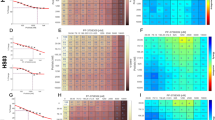Abstract
Plexiform neurofibromas (PNF), one of the major features of neurofibromatosis type 1 (NF1), are characterized by complex cellular composition and mostly slow but variable growth patterns. In this study, we examined the effect of imatinib mesylate, a receptor tyrosine kinase inhibitor, on PNF-derived Schwann cells and PNF tumour growth in vitro and in vivo. In vitro, PNF-derived primary Schwann cells express platelet-derived growth factors receptors (PDGFR) α and β, both targets of imatinib, and cell viability was reduced by imatinib mesylate, with 50% inhibition concentration (IC50) of 10 μM. For in vivo studies, PNF tumour fragments xenografted onto the sciatic nerve of athymic nude mice were first characterized. The tumours persisted for at least 63 days and maintained typical characteristics of PNFs such as complex cellular composition, low proliferation rate and angiogenesis. A transient enlargement of the graft size was due to inflammation by host cells. Treatment with imatinib mesylate at a daily dose of 75 mg/kg for 4 weeks reduced the graft size by an average of 80% (n = 8), significantly different from the original sizes within the group and from sizes of the grafts in 11 untreated mice in the control group (P < 0.001). We demonstrated that grafting human PNF tumour fragments into nude mice provides an adequate in vivo model for drug testing. Our results provide in vivo and in vitro evidence for efficacy of imatinib mesylate for PNF.





Similar content being viewed by others
Abbreviations
- GST:
-
Glutathione transferase
- PNF:
-
Plexiform neurofibromas
- NF1:
-
Neurofibromatosis type 1
- MPNSTs:
-
Malignant peripheral nerve sheath tumours
- PDGFR:
-
Platelet-derived growth factor receptor
- DMEM:
-
Dulbecco’s modified essential medium
- PAS:
-
Periodic acid-Schiff
- VEGF:
-
Vascular endothelial growth factor
- DAPI:
-
4′,6-Diamidino-2-phenylindole
- SCID:
-
Severe combined immunodeficiency
References
Tonsgard JH, Kwak SM, Short MP, Dachman AH (1998) CT imaging in adults with neurofibromatosis-1: frequent asymptomatic plexiform lesions. Neurology 50(6):1755–1760
Mautner VF, Hartmann M, Kluwe L, Friedrich RE, Funsterer C (2006) MRI growth patterns of plexiform neurofibromas in patients with neurofibromatosis type 1. Neuroradiology 48(3):160–165. Epub 2006 Jan 24
Tucker T, Friedman JM, Friedrich RE, Wenzel R, Funsterer C, Mautner VF (2008) Longitudinal study of neurofibromatosis 1 associated plexiform neurofibromas. J Med Genet 17:17
Evans DG, Baser ME, McGaughran J, Sharif S, Howard E, Moran A (2002) Malignant peripheral nerve sheath tumours in neurofibromatosis 1. J Med Genet 39(5):311–314
Druker BJ, Guilhot F, O’Brien SG, Gathmann I, Kantarjian H, Gattermann N, Deininger MW, Silver RT, Goldman JM, Stone RM et al (2006) Five-year follow-up of patients receiving imatinib for chronic myeloid leukemia. N Engl J Med 355(23):2408–2417
Demetri GD, von Mehren M, Blanke CD et al (2002) Efficacy and safety of imatinib mesylate in advanced gastrointestinal stromal tumors. N Engl J Med 347(7):472–480
Holtkamp N, Okuducu AF, Mucha J et al (2006) Mutation and expression of PDGFRA and KIT in malignant peripheral nerve sheath tumors, and its implications for imatinib sensitivity. Carcinogenesis 27(3):664–671. Epub 2005 Dec 15
Yang FC, Ingram DA, Chen S et al (2008) Nf1-dependent tumors require a microenvironment containing Nf1+/−and c-kit-dependent bone marrow. Cell 135(3):437–448
Gutmann DH, Aylsworth A, Carey JC et al (1997) The diagnostic evaluation and multidisciplinary management of neurofibromatosis 1 and neurofibromatosis 2. JAMA 278(1):51–57
Frahm S, Mautner VF, Brems H et al (2004) Genetic and phenotypic characterization of tumor cells derived from malignant peripheral nerve sheath tumors of neurofibromatosis type 1 patients. Neurobiol Dis 16(1):85–91
Bihorel S, Camenisch G, Gross G et al (2006) Influence of hydroxyurea on imatinib mesylate (gleevec) transport at the mouse blood-brain barrier. Drug Metab Dispos 34(12):1945–1949
Weisberg E, Catley L, Wright RD et al (2007) (2007) Beneficial effects of combining nilotinib and imatinib in preclinical models of BCR-ABL + leukemias. Blood 109(5):2112–2120
Babovic-Vuksanovic D, Petrovic L, Knudsen BE, Plummer TB, Parisi JE, Babovic S, Platt JL (2004) Survival of human neurofibroma in immunodeficient mice and initial results of therapy with pirfenidone. J Biomed Biotechnol 2004(2):79–85
Lee JK, Sobel RA, Chiocca EA, Kim TS, Martuza RL (1992) Growth of human acoustic neuromas, neurofibromas and schwannomas in the subrenal capsule and sciatic nerve of the nude mouse. J Neurooncol 14(2):101–112
Perrin GQ, Fishbein L, Thomson SA et al (2007) Plexiform-like neurofibromas develop in the mouse by intraneural xenograft of an NF1 tumor-derived Schwann cell line. J Neurosci Res 85(6):1347–1357
Lasater EA, Bessler WK, Mead LE et al (2008) Nf1+/− mice have increased neointima formation via hyperactivation of a gleevec sensitive molecular pathway. Hum Mol Genet 17(15):2336–2344
Acknowledgments
This study was sponsored by US Department of Defense (W81XWH-06-1-0280 and W81XWH-07-1-0359 to V. Mautner). We are very grateful to Novartis AG for the kind gift of imatinib mesylate.
Author information
Authors and Affiliations
Corresponding author
Rights and permissions
About this article
Cite this article
Demestre, M., Herzberg, J., Holtkamp, N. et al. Imatinib mesylate (Glivec) inhibits Schwann cell viability and reduces the size of human plexiform neurofibroma in a xenograft model. J Neurooncol 98, 11–19 (2010). https://doi.org/10.1007/s11060-009-0049-4
Received:
Accepted:
Published:
Issue Date:
DOI: https://doi.org/10.1007/s11060-009-0049-4




